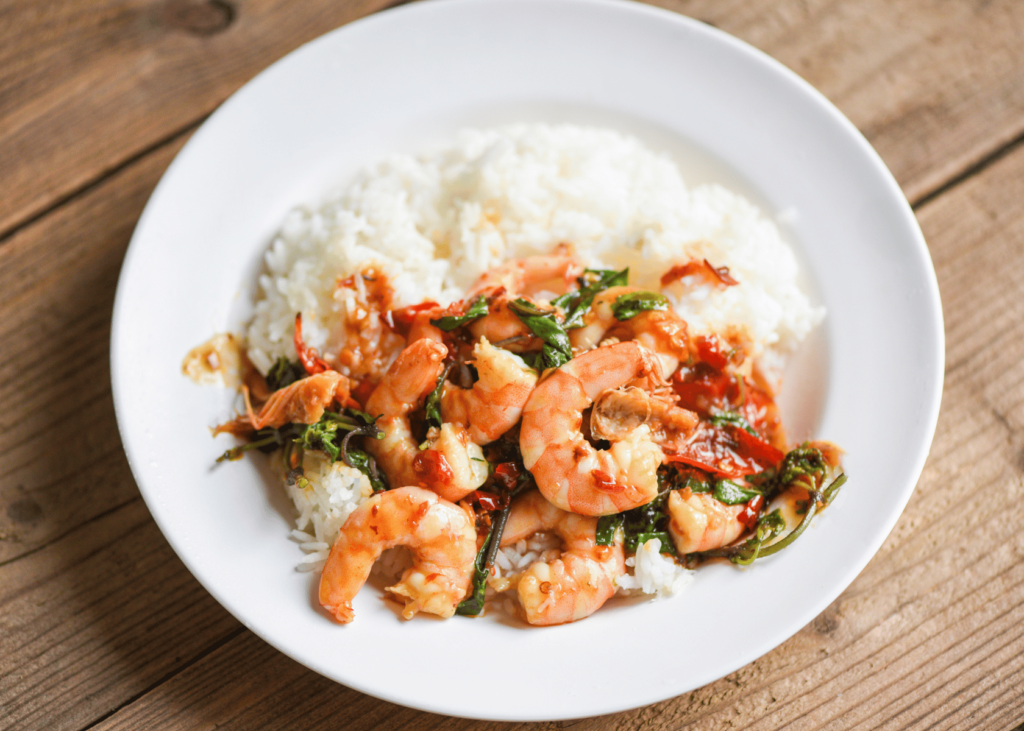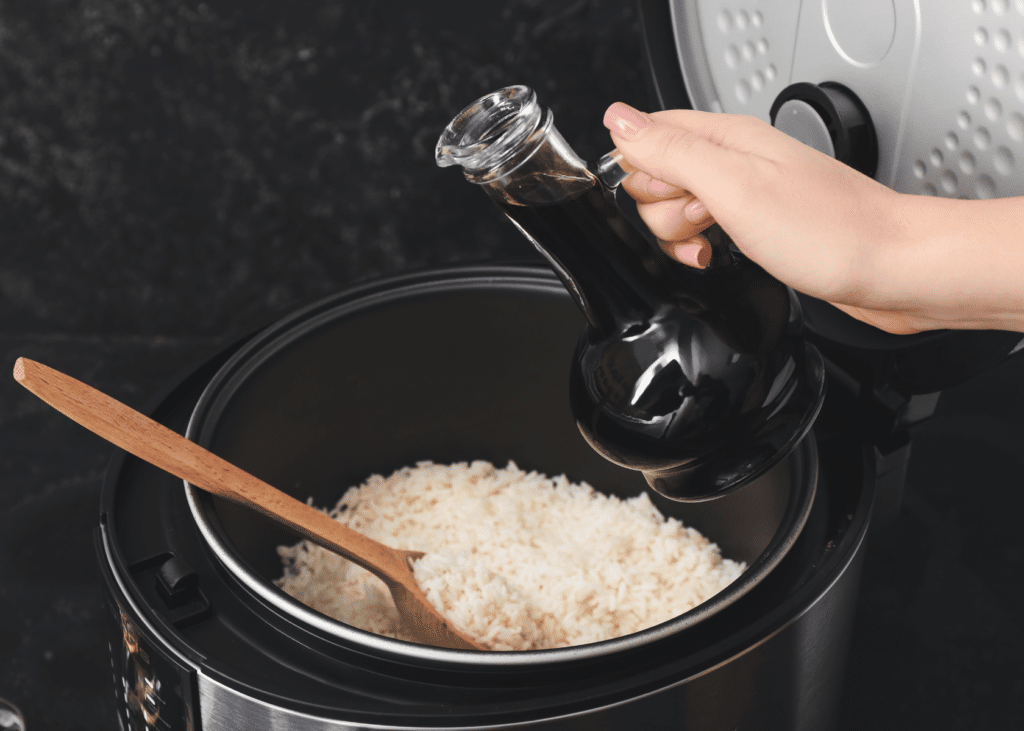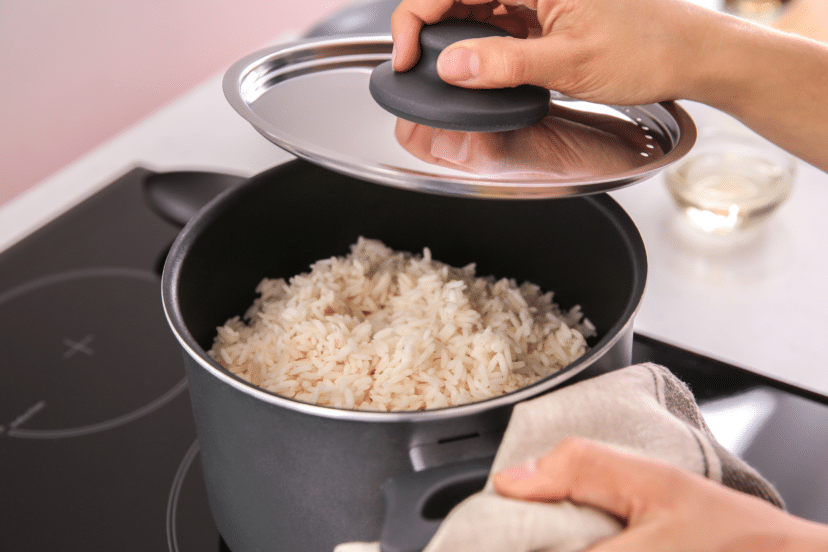Cooking Rice in a Crock-Pot: Easy Steps for Perfectly Fluffy Rice
Have you ever thought about cooking rice in a crock pot? It may surprise you to learn that this simple, hands-off method can yield fluffy, perfectly cooked grains. This article will guide you through the common question: can you cook rice in the crock-pot – will walk you through the steps, providing tips and tricks along the way to ensure your success.
Ready for an easy approach to a staple food item? Dive in!
Table of Contents
Key Takeaways
- Cooking rice in a crock pot is possible and offers convenience, resulting in fluffy and evenly cooked grains.
- The equipment needed includes a crock pot, measuring cups, a wooden or silicon spoon, a knife, a cutting board, and oven mitts.
- Basic ingredients for cooking rice in the crock pot include rice (any type), water or broth (2: 1 ratio), salt (optional), and cooking spray/oil (optional).
- Follow simple instructions, like rinsing the rice, adding it to the crock pot with water, broth, and optional seasonings, mixing well, and setting cooking time and temperature to low or high heat based on the preference or model of the crock pot used.
- Monitor periodically and check for doneness after the recommended cooking time. Fluff gently with a fork or spoon before serving.
- Tips for success include maintaining the right rice-to-water ratio (1: 2), adjusting quantities per personal preference, and considering different cooking times depending on the rice type and consistency desired.
- Stirring occasionally during cooking helps distribute heat evenly and prevents sticking. Regular monitoring avoids overcooking/burning.
- Advantages of using a crock-pot include convenience and time-saving as it requires minimal monitoring, results in fluffy/evenly cooked rice, and reduces risk of burning/overcooking compared to stovetop methods.
- Adding flavor can be done by incorporating spices/herbs like garlic, onion powder, and turmeric; fresh herbs like parsley, cilantro, and basil; bay leaves; chili flakes/powder; lemon zest; soy sauce/ tamari; and smoked paprika into the mix before cooking. Mixing vegetables and proteins also enhances taste and nutritional value of the dish.
Can You Cook Rice in the Crock-Pot?
Cooking rice in the crock-pot is a simple and convenient method that yields fluffy, evenly cooked grains.
Equipment needed
Succeeding in the kitchen calls for a few standard tools, especially when venturing into new cooking territories like making rice in a crock-pot. First on the list is the slow cooker itself, which is able to maintain a low and steady temperature for several hours. In addition to the crock-pot, you’ll need a set of measuring cups to accurately measure your rice and water ratio. A long-handled wooden or silicon spoon comes in handy for stirring without damaging your pot’s surface. Don’t forget, a sharp knife and cutting board will be needed if you’re planning on adding any fresh vegetables or proteins to your dish. Finally, keep some oven mitts nearby; these will protect your hands from possible burns while handling the hot crockpot. With these essential items at your disposal, you’re all set to master slow cooker rice recipes!
Basic ingredients
To cook rice in the crock-pot, you will need the following basic ingredients:
- Rice: Any type of rice can be used in a slow cooker, such as white rice, brown rice, or even basmati rice. Choose the type of rice that suits your preferences or recipe.
- Water or broth: To cook the rice properly, you will need to add liquid to the crock pot. The general rule is to use a 2:1 ratio of water to rice. For example, if you are using 1 cup of rice, add 2 cups of water.
- Salt (optional): If desired, you can add salt to enhance the flavor of the rice. Use about ½ teaspoon for every cup of uncooked rice.
- Cooking spray or oil (optional): Some people like to spray or lightly coat the inside of the crock-pot with cooking spray or oil to prevent sticking.
Cooking instructions
To cook rice in a crock-pot, follow these simple instructions:
- Rinse the rice: Before cooking, rinse the rice thoroughly under cold water to remove any excess starch.
- Add rice and water: In the crock-pot, combine one cup of rinsed rice with two cups of water. Adjust the quantities based on how much rice you want to cook.
- Seasoning (optional): If desired, add salt or other seasonings to enhance the flavor of the rice.
- Mix well: Gently stir the ingredients together to ensure even distribution of the rice and water.
- Set cooking time and temperature: Depending on your crock-pot model and desired cooking method, set it to either high or low heat. Generally, cooking on low for 2-3 hours or on high for 1-2 hours works well for white rice.
- Leave it undisturbed: Once you set the timer, avoid opening the lid during cooking, as this can affect the temperature and cooking time.
- Check for doneness: After the recommended cooking time has passed, open the lid and check if the rice is cooked to your liking. The texture should be tender but not mushy.
- Fluff and serve: Use a fork or spatula to fluff up the cooked rice gently. Serve hot alongside your favorite dishes or use it as a base for flavorful one-pot meals.
Tips for Cooking Rice in the Crock-Pot

To ensure perfectly cooked rice in the crock-pot, use a 1:2 ratio of rice to water and cook on low for 2-3 hours or on high for 1-2 hours, stirring occasionally.
Rice-to-water ratio
To achieve perfectly cooked rice in a crock-pot, it is essential to maintain the right rice-to-water ratio. The general rule of thumb is to use 1 cup of rice for every 2 cups of water. This ensures that the rice absorbs enough liquid during the cooking process without becoming too mushy or dry.
However, keep in mind that this ratio may vary slightly depending on the type and brand of rice you are using. It’s always a good idea to refer to package instructions or specific recipe guidelines for precise measurements.
Adjusting the amount of water may also be necessary if you prefer your rice to be stickier or fluffier. By following these simple steps and keeping an eye on your slow cooker, you’ll have beautifully cooked rice every time without any fuss or hassle.”.
Cooking time
To cook rice in a crock-pot, it is important to consider the cooking time. Different recipes may call for different cooking times, depending on the type of rice being used and the desired consistency.
For example, white rice typically takes around 2-3 hours on low heat or 1-2 hours on high heat in a slow cooker. Brown rice, on the other hand, usually requires a longer cooking time of about 4-5 hours on low or 2-3 hours on high.
It’s essential to note that these are just general guidelines, as every slow cooker can vary slightly in temperature and cooking efficiency. To ensure perfectly cooked rice, it’s best to check the texture periodically as you approach the recommended cooking time.
The rice should be tender but still have some firmness and not be mushy.
Stirring and monitoring
To ensure perfectly cooked rice in a crock-pot, it’s crucial to stir and monitor the cooking process. Regularly stirring the rice helps distribute heat evenly and prevents it from sticking to the bottom of the pot.
This simple act also promotes even moisture distribution throughout the grains, resulting in fluffy and tender rice. Additionally, monitoring is essential to prevent overcooking or burning. By keeping an eye on the rice as it cooks, you can adjust cooking times accordingly and achieve your desired texture.
So remember to give your slow cooker rice a good stir every now and then while keeping a watchful eye for deliciously cooked results.
Advantages of Cooking Rice in the Crock-Pot
Cooking rice in the crock pot offers unmatched convenience and time savings, resulting in fluffy and evenly cooked rice with a reduced risk of burning or overcooking. Discover how to transform simple rice into a delicious one-pot meal effortlessly!
Convenience and time-saving
Cooking rice in a crock-pot offers the convenience of preparing a staple food without constant monitoring. With just a few simple steps, you can have perfectly cooked rice ready to serve. By adding the desired amount of rice and water to your slow cooker, setting the cooking time, and letting it do its magic, you can save valuable time and effort in meal preparation.
Whether you’re busy with other tasks or simply want to enjoy hands-off cooking, using a crock-pot for rice ensures that you’ll have fluffy grains every time without the risk of burning or overcooking.
Fluffy and evenly cooked rice
One of the advantages of cooking rice in a crock-pot is that it results in fluffy and evenly cooked rice. Unlike traditional stovetop methods, where you need to keep an eye on the pot and make sure the heat is just right, a slow cooker maintains a consistent temperature throughout the cooking process.
This gentle and even heat distribution allows the rice to cook slowly and evenly, resulting in perfectly fluffy grains every time.
Not only does this method ensure that each grain is cooked uniformly, but it also prevents any scorching or burning that can occur with direct heat. With a crock-pot, you don’t need to worry about constantly stirring or monitoring the rice as it cooks.
Simply add your desired ratio of rice and water into the slow cooker, set it for the recommended cooking time, and let it do its magic.
Whether you’re serving plain white rice as a side dish or incorporating flavored variations like cilantro-lime or coconut-infused rice into your meals, using a crock-pot ensures that each spoonful will be light, airy, and full of deliciousness.
Reduced risk of burning or overcooking
Cooking rice in a crock-pot significantly reduces the risk of burning or overcooking. Unlike cooking on a stovetop, where it’s easy to get distracted and end up with burnt or soggy rice, the slow and steady heat of a crock-pot ensures evenly cooked grains every time.
This means you can set it and forget it, allowing you to focus on other tasks without worrying about ruining your rice. With the proper water-to-rice ratio and cooking time, you’ll achieve perfectly fluffy rice that is neither undercooked nor mushy.
Say goodbye to scorched pots and hello to hassle-free rice with this foolproof method!
Variations and Additions for Crock-Pot Rice

Incorporate additional flavors into your crock-pot rice by adding spices or herbs, making it truly customizable.
Adding flavor with spices or herbs
Adding flavor to your crock-pot rice is a simple way to elevate its taste and make it more exciting. Here are some ideas for adding spices or herbs to your slow cooker rice:
- Garlic: Adding minced garlic to the rice can infuse it with a savory and aromatic flavor.
- Onion powder: Sprinkling onion powder over the rice before cooking can give it a subtle, sweet onion taste.
- Turmeric: Incorporating turmeric into your crock-pot rice not only adds a bright yellow color but also brings a slightly earthy flavor.
- Cumin: A pinch of cumin can add warmth and depth to your rice, giving it a delicious Indian-inspired twist.
- Bay leaves: Placing dried bay leaves in the pot while the rice cooks imparts a subtle herbal aroma and enhances its overall flavor.
- Fresh herbs: Finely chop fresh herbs like parsley, cilantro, or basil, and mix them into the cooked rice for a burst of freshness and vibrant taste.
- Chili flakes or powder: For those who prefer some heat, adding chili flakes or powder can spice up your crock-pot rice.
- Lemon zest: Grate some lemon zest over the cooked rice to add a refreshing citrusy note that pairs well with various dishes.
- Soy sauce or tamari: drizzling some soy sauce or tamari into the mixture before cooking gives the rice a savory umami flavor.
- Smoked paprika: A sprinkle of smoked paprika adds a smoky undertone to your crock-pot rice, making it more complex and flavorful.
Mixing in vegetables or proteins
Mixing vegetables or proteins into your crock-pot rice can elevate its flavor and nutritional value. Here are some delicious and healthy options to consider:
- Sautéed Vegetables: Add a colorful mix of sautéed vegetables like onions, bell peppers, carrots, and peas to your rice. This will not only enhance the taste but also provide added nutrients.
- Protein-packed Chicken: Cook diced chicken breast separately and then stir it into the cooked rice before serving. The tender chicken will blend perfectly with the fluffy rice, creating a satisfying meal.
- Flavorful Shrimp: Pan-fry some shrimp with garlic and spices until they turn pink and slightly crispy. Toss them into the finished rice for a burst of seafood goodness.
- Nutty Tofu: For a vegetarian option, try adding cubed tofu to the crock-pot along with the rice and water. The tofu will absorb the flavors of the dish and provide a satisfying texture.
- Spiced Sausage: Brown some sliced sausage in a skillet before adding it to the crock-pot with the rice. The smoky flavors of the sausage will infuse into every bite.
- Mixed Beans: Boost your protein intake by mixing cooked beans such as black beans, kidney beans, or chickpeas into your crock-pot rice.
- Seasonal Vegetables: Experiment with seasonal vegetables like roasted butternut squash or grilled zucchini to add variety and depth to your rice dish.
Using different types of rice
Different types of rice can be used in a crock-pot to add variety and flavor to your dishes. Here are some options to consider:
- White rice: This is the most common type of rice used for cooking in a crock-pot. It has a mild flavor and a fluffy texture when cooked.
- Brown rice: If you prefer a healthier option, brown rice is a great choice. It has more fiber and nutrients compared to white rice, but it takes longer to cook in a slow cooker.
- Basmati rice: Known for its aromatic fragrance, basmati rice adds a unique flavor to any dish cooked in a crock-pot. It pairs well with Indian and Middle Eastern flavors.
- Jasmine rice: Popular in Thai cuisine, jasmine rice has a subtly sweet aroma that enhances the overall taste of your crock-pot meals.
- Wild rice: Although technically not a true rice, wild rice offers a nutty and earthy flavor that complements hearty stews or casseroles cooked in the crock-pot.
- Arborio or risotto rice: If you’re planning on making creamy risotto dishes in your crock-pot, arborio or other short-grain varieties of risotto rice work best, as they release starch slowly during cooking.
- Sushi or short-grain sticky rice: Ideal for making sushi rolls or other Asian-inspired dishes, this type of grain becomes sticky when cooked, making it easier to handle and shape.
FAQs
1. Can you cook rice in a crock-pot?
Yes, you can cook rice in a crock-pot. It is a convenient method for preparing large batches of rice and keeping it warm.
2. How long does it take to cook rice in a crock-pot?
The cooking time for rice in a crock-pot varies depending on the type of rice used and the specific model of the crock-pot. Generally, it takes around 2-4 hours on low heat or 1-2 hours on high heat.
3. What is the recommended ratio of water to rice when cooking in a crock-pot?
The general rule for cooking white or jasmine rice in a crock-pot is to use 1 ½ cups of water for every cup of dry rice. However, this ratio may vary slightly based on personal preference and the specific instructions provided with your particular brand/model.
4. Are there any tips for getting perfect results when cooking rice in a crock-pot?
To ensure perfect results when cooking rice in a crock-pot, it’s important to rinse the rice thoroughly before adding it to the pot. Additionally, avoid lifting the lid during cooking, as this will release steam and affect the cooking time and texture of the final product. Finally, fluffing the cooked rice with a fork before serving will help distribute any moisture evenly throughout each grain.
Conclusion
In conclusion, cooking rice in the crock-pot is not only possible but also incredibly convenient. With just a few basic ingredients and some simple instructions, you can enjoy perfectly cooked rice every time.
Whether you prefer plain white rice or want to get creative with flavors and additions, the crock-pot offers a hassle-free way to prepare this versatile grain. Say goodbye to stovetop monitoring and hello to fluffy and delicious rice with minimal effort—your taste buds will thank you!
*We may earn a commission for the purchases made using our links. Please see our disclosure to learn more.




